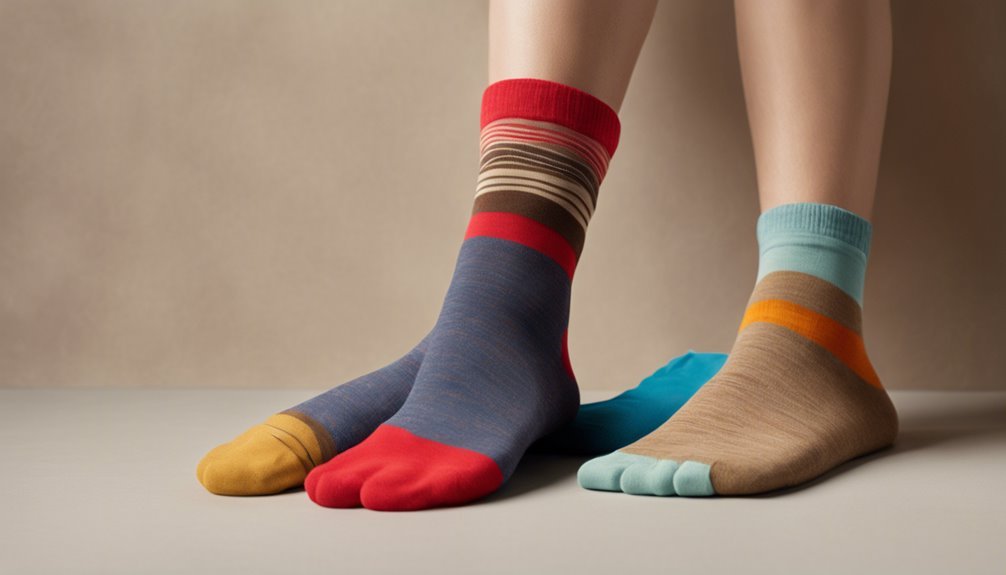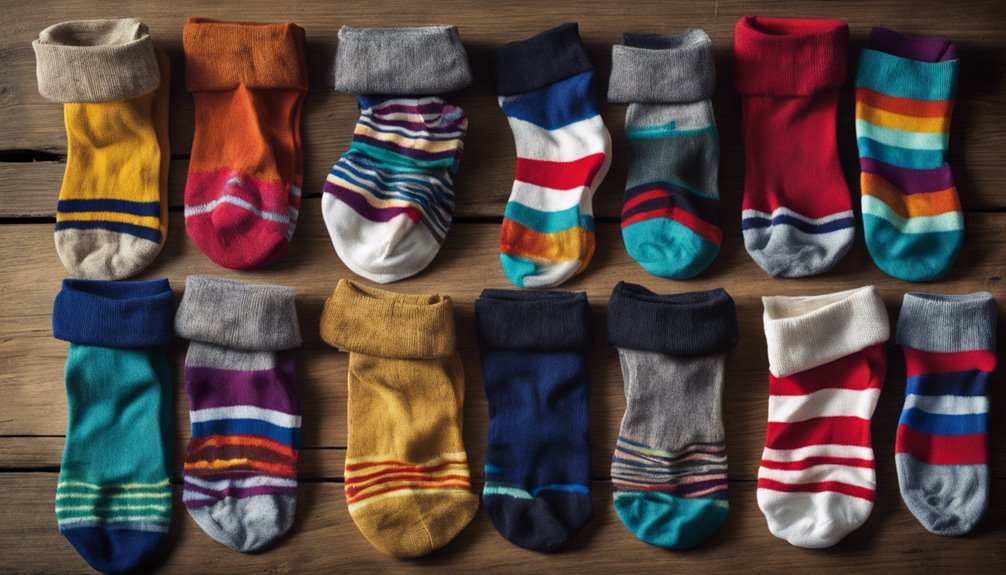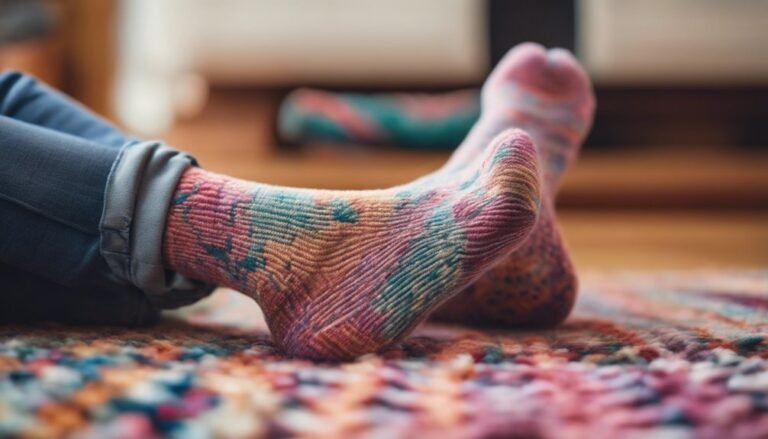Toe Socks vs. Traditional Socks: Are They Better for Foot Health?
Toe socks provide significant benefits for foot health compared to traditional socks. Their design promotes natural toe alignment, enhancing stability and reducing bunion risks. They also offer excellent moisture management, which can prevent fungal infections. While traditional socks are more familiar and comfortable for casual use, toe socks are better suited for active lifestyles due to their superior elasticity and blister prevention. If you're curious about the specific advantages and features of each sock type, further information awaits you.
Understanding Toe Socks and Their Design

Although toe socks may seem like a quirky fashion choice, their design is rooted in functionality and comfort. This innovative design considers foot anatomy, allowing for each toe to move independently. By separating the toes, toe socks promote better circulation and reduce friction, which can be beneficial for those who prioritize freedom in movement. The design innovation not only enhances tactile sensitivity but also aids in balance and stability. Unlike traditional socks, which can constrict toe movement, toe socks embrace a more natural position, catering to the foot's anatomical structure. This approach highlights an understanding of how footwear can impact overall foot health, making toe socks a unique alternative for individuals seeking both comfort and performance in their daily activities.
The Benefits of Toe Socks for Foot Health
When you consider the impact of footwear on foot health, toe socks offer several advantages that can enhance your overall well-being. One of the key toe socks benefits is their ability to promote natural toe alignment, which can reduce the risk of bunions and other deformities. By allowing each toe to move independently, toe socks improve circulation and decrease moisture buildup, minimizing the chance of fungal infections. Additionally, their snug fit can provide better support during physical activities, enhancing stability and reducing the likelihood of blisters. Overall, incorporating toe socks into your wardrobe can lead to improved foot health, offering a freedom of movement that traditional socks often restrict. Embracing this innovative design can greatly influence your foot care routine.
The Advantages of Traditional Socks
When considering traditional socks, comfort and warmth are two significant advantages that stand out. Their design typically provides an insulating layer that helps regulate temperature, making them suitable for various climates. Additionally, traditional socks often feature materials engineered for enhanced moisture control, which can keep your feet dry and comfortable throughout the day.
Comfort and Warmth
While toe socks offer unique benefits, traditional socks remain a preferred choice for many due to their superior comfort and warmth. Traditional socks are designed to provide excellent heat retention, ensuring that your feet stay warm in colder conditions. The material used in these socks often contributes to a cozy feel against your skin, enhancing overall comfort. Additionally, traditional socks allow for more foot flexibility, accommodating various foot shapes without restrictive seams or divisions. This flexibility can lead to a more natural foot movement, promoting a sense of freedom while walking or engaging in activities. In environments where warmth and comfort are paramount, traditional socks often prove to be the more practical and enjoyable option for everyday wear.
Enhanced Moisture Control
Traditional socks excel in moisture control, a significant advantage for maintaining foot health and comfort. Their fabric typically features moisture-wicking properties that draw sweat away from your feet, keeping them dry throughout the day. This is essential in preventing conditions like athlete's foot and other fungal infections. Additionally, traditional socks often incorporate materials that enhance odor control, further contributing to foot hygiene. By managing moisture effectively, these socks reduce the risk of unpleasant odors and create a more pleasant wearing experience. Ultimately, if you value foot health, the superior moisture management offered by traditional socks can help you maintain comfort and well-being, allowing you to enjoy greater freedom in your daily activities without the worry of dampness or odor.
Comparing Comfort Levels: Toe Socks vs. Traditional Socks
Although individual preferences vary, the comfort levels of toe socks and traditional socks can greatly impact your overall foot health and satisfaction. In a comfort comparison, toe socks often provide a more natural fit, allowing each toe to move independently, which some find enhances foot sensitivity. This can lead to increased comfort, especially during activities like running or yoga. On the other hand, traditional socks may offer a snugger fit around the foot, appealing to those who prefer a more uniform feel. However, this can result in pressure points for some individuals. Ultimately, your choice should consider your foot structure and activity level, as comfort levels directly influence your well-being and enjoyment in daily activities.
Moisture Management: Which Sock Performs Better?

How do toe socks and traditional socks stack up when it comes to moisture management? Both types aim to keep your feet dry, but their effectiveness varies. Toe socks often excel in moisture absorption due to their individual toe compartments, which allow for better airflow and sweat wicking. Traditional socks, while often made from moisture-wicking materials, can sometimes trap sweat against the skin.
| Sock Type | Moisture Absorption | Sweat Wicking |
|---|---|---|
| Toe Socks | High | Excellent |
| Traditional Socks | Moderate | Good |
Impact on Circulation and Foot Alignment
The design of socks can greatly impact both circulation and foot alignment, factors that are often overlooked in discussions about comfort and performance. Toe socks, by allowing each toe to move freely, can enhance foot alignment, promoting a more natural foot position. This may lead to improved circulation benefits, as blood flow can be less restricted compared to traditional socks, which often compress the toes together. When your toes have the freedom to spread, it can help in maintaining proper alignment and reducing the risk of discomfort. Choosing the right sock design for your activities can thus play a critical role in supporting ideal foot health, ultimately contributing to your overall well-being and performance.
Toe Socks and Blister Prevention
When you consider the potential for blister prevention, toe socks offer distinct advantages over traditional sock designs. Their unique construction allows each toe to move independently, reducing friction between skin surfaces. This is critical in blister prevention techniques, as blisters often form due to repetitive rubbing. Additionally, toe sock materials, often made from moisture-wicking fabrics, help manage sweat, further minimizing the risk of blisters. By keeping your feet dry, these materials enhance comfort and reduce abrasion. If you're active, wearing toe socks can be a strategic choice to protect your feet, especially during long runs or hikes. Ultimately, choosing toe socks could be a proactive step towards healthier, blister-free feet.
Durability and Longevity of Sock Types

When considering the durability and longevity of toe socks versus traditional socks, it's crucial to examine the differences in material composition. The wear and tear resistance of each type can greatly impact their lifespan, as can proper care and maintenance practices. Understanding these factors will help you make an informed choice for your sock collection.
Material Composition Differences
Material composition plays an essential role in determining the durability and longevity of toe socks compared to traditional socks. Toe socks often utilize specialized blends, enhancing their elasticity and comfort. Traditional socks typically consist of cotton or wool, which can vary in durability based on the material types used. Below is a comparative analysis of their material composition:
| Sock Type | Material Composition |
|---|---|
| Toe Socks | Nylon, spandex, bamboo |
| Traditional Socks | Cotton, wool, polyester |
| Elasticity | High (due to spandex) |
| Longevity | Moderate (depends on care) |
Understanding these elasticity differences helps you choose the right sock type for your specific needs, ensuring ideal foot health and comfort.
Wear and Tear Resistance
Durability is an essential factor when evaluating the wear and tear resistance of toe socks versus traditional socks. In a durability comparison, toe socks often show superior wear resistance due to their snug fit around each toe, minimizing friction and reducing the likelihood of holes forming. Traditional socks, while comfortable, may wear out more quickly, especially in high-friction areas like the heel and toe. The materials used in both types also play an important role in their longevity; toe socks frequently incorporate synthetic fibers designed for enhanced durability. Ultimately, if you value extended use and robust performance, toe socks may offer an advantage in wear and tear resistance, making them a worthwhile consideration for your sock drawer.
Care and Maintenance Tips
To maximize the lifespan and performance of your socks, understanding proper care and maintenance practices is key. Implementing effective care routines can greatly enhance durability. For both toe socks and traditional socks, always follow the manufacturer's washing instructions. Generally, opt for cold water and a gentle cycle to minimize wear. Avoid fabric softeners, as they can break down fibers over time. After washing, air drying is preferable; heat can compromise elasticity and shape. Regularly inspect your socks for signs of wear, and rotate pairs to distribute usage evenly. By adopting these practices, you guarantee that your investment in foot health yields long-term benefits, allowing your socks to maintain their integrity and functionality.
Personal Preference: Lifestyle and Activity Considerations
While some may prefer the traditional sock for its familiarity, others find that toe socks better align with their active lifestyles. Your lifestyle choices and activity preferences play a significant role in determining which sock type suits you best. If you engage in activities like yoga or running, toe socks can enhance flexibility and grip, allowing for improved foot movement. Conversely, if you prioritize warmth and comfort during casual outings, traditional socks might be more appealing. Ultimately, the choice lies in how you balance your daily activities with your sock preferences. By considering your specific needs and habits, you can make an informed decision that supports both comfort and foot health, ensuring your footwear complements your unique lifestyle.
Price and Availability: A Practical Comparison
How do toe socks and traditional socks compare with regard to price and availability? With respect to price comparison, traditional socks generally cost less, with basic pairs available for a few dollars. Toe socks, however, tend to be more expensive due to their unique design and materials, often ranging from $10 to $20. Availability options also differ; traditional socks are widely available in department stores, sports retailers, and online platforms. Toe socks may be found in specialty stores or selected online retailers, which could limit your options. If you're considering foot health benefits, weigh the higher cost of toe socks against their potential advantages, while keeping your budget and access in mind.
Frequently Asked Questions
Can Toe Socks Be Worn With Regular Shoes?
Yes, toe socks can be worn with regular shoes, though shoe compatibility varies. They offer unique style options, but make certain your shoes provide enough space to accommodate the toe separation for ideal comfort and fit.
Are Toe Socks Recommended for People With Foot Conditions?
Toe socks can be beneficial for people with various foot conditions. They may promote better alignment and circulation, providing health benefits that traditional socks might not. Always consult a healthcare professional for personalized advice regarding your specific needs.
How Do Toe Socks Affect Athletic Performance?
You'd think a sock's just a sock, but toe socks can enhance your performance benefits by promoting natural toe splay. This can lead to better balance and injury prevention, ultimately boosting your athletic efficiency.
Do Toe Socks Come in Different Materials?
Yes, toe socks do come in various material options, such as cotton, wool, and synthetic blends. Each fabric offers unique benefits, including moisture-wicking properties, warmth, and breathability, catering to different preferences and activities for ideal comfort.
How Should I Care for Toe Socks?
Caring for toe socks is like nurturing a delicate garden. Follow washing instructions carefully, using cold water and mild detergent. For drying tips, air-dry them flat to maintain their shape and longevity.







